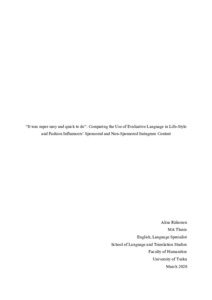“It was super easy and quick to do”: Comparing the Use of Evaluative Language in Life-Style and Fashion Influencers’ Sponsored and Non-Sponsored Instagram Content
Riikonen, Alisa (2020-04-02)
“It was super easy and quick to do”: Comparing the Use of Evaluative Language in Life-Style and Fashion Influencers’ Sponsored and Non-Sponsored Instagram Content
Riikonen, Alisa
(02.04.2020)
Julkaisu on tekijänoikeussäännösten alainen. Teosta voi lukea ja tulostaa henkilökohtaista käyttöä varten. Käyttö kaupallisiin tarkoituksiin on kielletty.
avoin
Julkaisun pysyvä osoite on:
https://urn.fi/URN:NBN:fi-fe2020050825765
https://urn.fi/URN:NBN:fi-fe2020050825765
Tiivistelmä
Social media platforms have created a new profession, a social media influencer. Influencers earn their income by working together with brands or companies and advertising products to their followers. It is argued that influencers can manipulate the followers’ impression of the advertised item, and thus affect their purchase intention. When influencers evaluate products on their content, they can “impose” their ideas and opinions to their followers, who value and trust the influencer and what they say. The purpose of this thesis is to examine and compare the use of evaluative language in Instagram influencers’ content. The research questions are as follows: How does the evaluative use of attitude differ between sponsored, non-sponsored, and ambiguous posts, if any? What kinds of engagement resources are used, and how do they differ between sponsored, non-sponsored, and ambiguous posts? How are graduation values applied in the content, and how does the use differ between sponsored, non-sponsored, and ambiguous posts? If there are notable differences in the use of the three domains of the framework between the three types of posts, where do they stem from?
Martin and White’s appraisal framework is used as a base for the analysis. Each domain of the framework, attitude, engagement and graduation, are considered, in order to provide a comprehensive understanding of the language on this type of content. Furthermore, the targets of attitude and graduation are analyzed. The material is collected from four individual English- speaking influencers, who focus on fashion, beauty and life-style content. The material is divided into three even groups, sponsored, non-sponsored and ambiguous content, to provide an impartial comparison of the language used in the content groups.
I hypothesized that sponsored content would involve more positive attitude, expansive engagement and up-scaling graduation than the other two content groups. While for the most part the language in all three content groups is similar, the results show the hypothesis to be partially correct, as sponsored content is found to involve more persuasive language in comparison to the other groups. However, it is impossible to know if the differences found are intentional, but they may influence the readers differently regardless of intention. In addition, more studies are required to see how the readers recognize or interpret such language in the content.
Martin and White’s appraisal framework is used as a base for the analysis. Each domain of the framework, attitude, engagement and graduation, are considered, in order to provide a comprehensive understanding of the language on this type of content. Furthermore, the targets of attitude and graduation are analyzed. The material is collected from four individual English- speaking influencers, who focus on fashion, beauty and life-style content. The material is divided into three even groups, sponsored, non-sponsored and ambiguous content, to provide an impartial comparison of the language used in the content groups.
I hypothesized that sponsored content would involve more positive attitude, expansive engagement and up-scaling graduation than the other two content groups. While for the most part the language in all three content groups is similar, the results show the hypothesis to be partially correct, as sponsored content is found to involve more persuasive language in comparison to the other groups. However, it is impossible to know if the differences found are intentional, but they may influence the readers differently regardless of intention. In addition, more studies are required to see how the readers recognize or interpret such language in the content.
